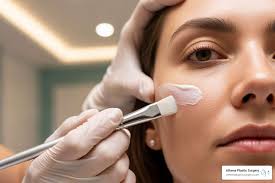Aesthetic centers provide a range of professional services designed to enhance the cosmetic appearance. These facilities are staffed by trained practitioners who perform non-invasive or minimally invasive procedures. When you visit an aesthetic center for facial treatments, the team works with you to understand your goals, and they aim to help you achieve the results you desire. Here is more information on aesthetic center treatments:
1. Skin Regeneration
One approach to skin rejuvenation involves the use of polydeoxyribonucleotide (PDRN). This substance is derived from salmon DNA and is used in specific topical or injectable treatments administered by professionals. PDRN works at a cellular level to support the skin’s natural repair processes, and it plays a role in enhancing the body’s ability to heal itself.
When applied, PDRN provides building blocks that aid in tissue restoration. This process may help improve skin texture and elasticity over time. The treatments are typically performed in a series, and a practitioner can help you understand the process and what to expect during your appointments.
This method focuses on supporting the skin’s own ability to regenerate. Patients may find a noticeable improvement in their skin’s overall appearance after completing the recommended treatment sessions. With proper aftercare and guidance from your provider, the results may be long-lasting and contribute to healthier, more vibrant skin.
2. Nitrous Oxide Therapy
Practitioners at an aesthetic center can use nitrous oxide therapy to address certain skin concerns. During this treatment, a practitioner uses a device to apply a fine jet of nitrous oxide to targeted areas of the skin. The extreme cold freezes the unwanted skin cells, and these cells are then naturally eliminated by the body’s healing process.
3. Microneedling
Microneedling is a procedure that uses a specialized device to create tiny, controlled punctures in the skin’s surface. These micro-injuries trigger the body’s natural wound-healing response, which includes the production of collagen and elastin. Collagen and elastin are proteins that provide structure and firmness to the skin.
Before the procedure, practitioners apply a numbing cream to the area to promote your comfort. The practitioner then moves the microneedling device across the treatment area. A session typically takes about 30 minutes. Microneedling is often performed in a series of sessions spaced several weeks apart. This helps to build on the results of previous treatments. Your provider will work with you to create a schedule that aligns with your skin’s needs.
4. Chemical Peels
Chemical peels involve the application of a chemical solution to the skin, which causes it to exfoliate and eventually peel off. This process reveals new, smoother skin underneath. Peels come in different strengths, and a practitioner will help determine the appropriate type for your skin. During treatment, the solution is applied to the skin and left in place for a specific amount of time before being neutralized or removed. After the peel, your skin will go through a healing process, and it is helpful to follow the post-procedure care instructions provided by your aesthetician.
Find an Aesthetic Center
Finding the right aesthetic center is a key step in exploring facial treatment options. Research local centers and seek out qualified, experienced practitioners who can offer clear and supportive guidance. A consultation is a great way to discuss your goals and learn about the available services. Take the next step by scheduling a consultation with a trusted aesthetic center near you to learn more about how these services may fit into your skincare routine.
- Aurö: A Comprehensive Guide to Mindful Design in AI, Branding, and Wellness Tech
- How a Certified Midwife Can Support Your Birth Experience
- Jadeitový Kameň: The Alluring Beauty and Power of Jadeite
- Plangud: A Comprehensive Overview for Construction and Carpentry Enthusiasts
- Nurture Tech Tips EmbedTree: Unlocking Growth and Advancing Skills in the Digital Age





